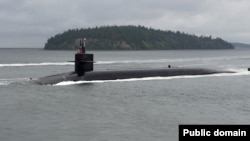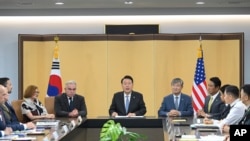The United States is backing tough talk on provocations and saber-rattling by North Korea with a show of force, sending a nuclear-armed submarine on a visit to South Korea.
The Ohio-class nuclear ballistic missile submarine USS Kentucky arrived Tuesday in the South Korean port of Busan, escorted by two, U.S. guided missile destroyers.
A statement from U.S. Forces Korea said the visit “reflects the United States’ ironclad commitment to the Republic of Korea,” and also “demonstrates the flexibility, survivability, readiness, resolve, and capability of the U.S. Navy submarine forces.”
The visit comes as high-level talks are underway in Seoul between U.S. and South Korean officials aimed at coordinating a nuclear response should war break out with North Korea.
White House Indo-Pacific coordinator Kurt Campbell, who is leading the U.S. delegation, confirmed the visit by the USS Kentucky, calling it the first visit by a nuclear armed submarine to South Korea since the 1980s.
Earlier this year, during a visit to Seoul by U.S. Defense Secretary Lloyd Austin, the two allies agreed to increase the pace and scope of military exercises and to expand intelligence sharing in response to the growing threat from North Korea.
The U.S. military would employ “the full range of U.S. defense capabilities, including our conventional, nuclear, and missile-defense capabilities,” to defend Seoul, Austin said at the time.
The USS Kentucky is capable of launching nuclear-capable Trident II ballistic missiles with a range of 12,000 kilometers.
In addition to the visit by the USS Kentucky, the U.S. currently has about 28,500 troops stationed in South Korea.
Just last month, North Korea test fired two short-range missiles while top U.S. officials were meeting Japanese and South Korean counterparts in Tokyo. And there are ongoing concerns in Washington that Pyongyang is preparing for more ballistic missile tests.
"I have been concerned for some time that North Korea would conduct what would be its seventh nuclear test," White House National Security Adviser Jake Sullivan told CBS's “Face the Nation” this past Sunday.
"I don't see any immediate indications that's going to happen, but it would not come as a surprise if North Korea moves forward with another test with respect to its intercontinental ballistic missile capability," he added.
Both U.S. and South Korean officials have repeatedly said that should North Korean use nuclear weapons against them or their allies that it would “result in the end of that regime.”
Eunice Kim contributed to this report from Seoul.












